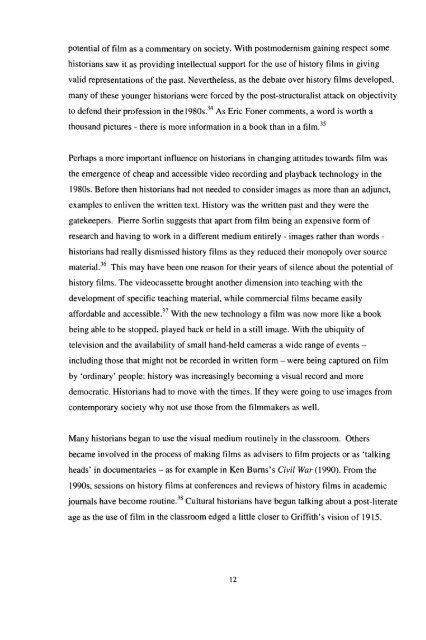Download (3483kB) - Greenwich Academic Literature Archive ...
Download (3483kB) - Greenwich Academic Literature Archive ...
Download (3483kB) - Greenwich Academic Literature Archive ...
- No tags were found...
You also want an ePaper? Increase the reach of your titles
YUMPU automatically turns print PDFs into web optimized ePapers that Google loves.
potential of film as a commentary on society. With postmodernism gaining respect somehistorians saw it as providing intellectual support for the use of history films in givingvalid representations of the past. Nevertheless, as the debate over history films developed,many of these younger historians were forced by the post-structuralist attack on objectivityto defend their profession in the 1980s. 34 As Eric Foner comments, a word is worth athousand pictures - there is more information in a book than in a film. 35Perhaps a more important influence on historians in changing attitudes towards film wasthe emergence of cheap and accessible video recording and playback technology in the1980s. Before then historians had not needed to consider images as more than an adjunct,examples to enliven the written text. History was the written past and they were thegatekeepers. Pierre Sorlin suggests that apart from film being an expensive form ofresearch and having to work in a different medium entirely - images rather than words -historians had really dismissed history films as they reduced their monopoly over sourcematerial. 36 This may have been one reason for their years of silence about the potential ofhistory films. The videocassette brought another dimension into teaching with thedevelopment of specific teaching material, while commercial films became easilyaffordable and accessible. 37 With the new technology a film was now more like a bookbeing able to be stopped, played back or held in a still image. With the ubiquity oftelevision and the availability of small hand-held cameras a wide range of events -including those that might not be recorded in written form - were being captured on filmby 'ordinary' people: history was increasingly becoming a visual record and moredemocratic. Historians had to move with the times. If they were going to use images fromcontemporary society why not use those from the filmmakers as well.Many historians began to use the visual medium routinely in the classroom. Othersbecame involved in the process of making films as advisers to film projects or as 'talkingheads' in documentaries - as for example in Ken Burns's Civil War (1990). From the1990s, sessions on history films at conferences and reviews of history films in academicjournals have become routine. 38 Cultural historians have begun talking about a post-literateage as the use of film in the classroom edged a little closer to Griffith's vision of 1915.12
















